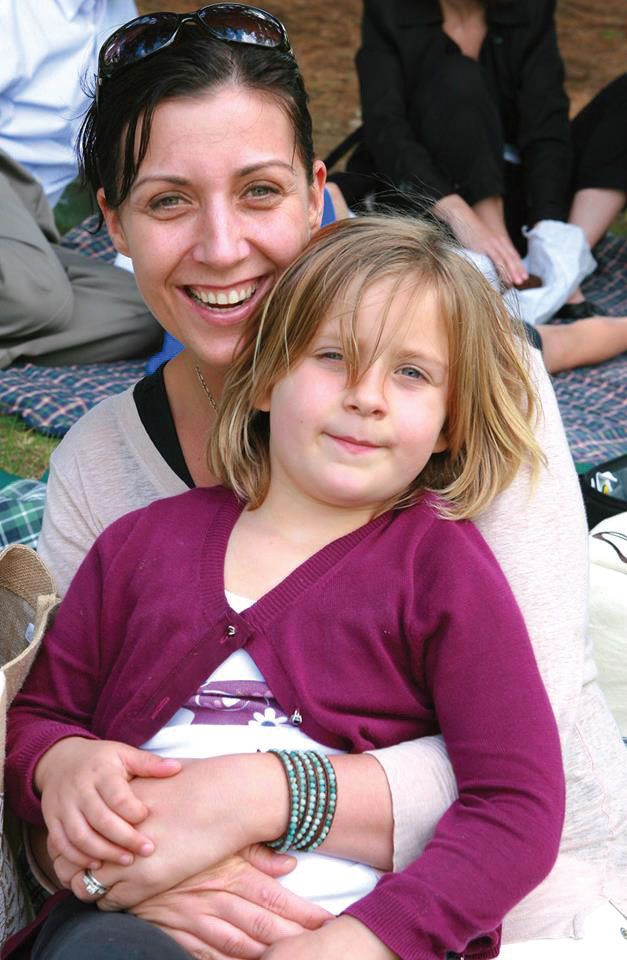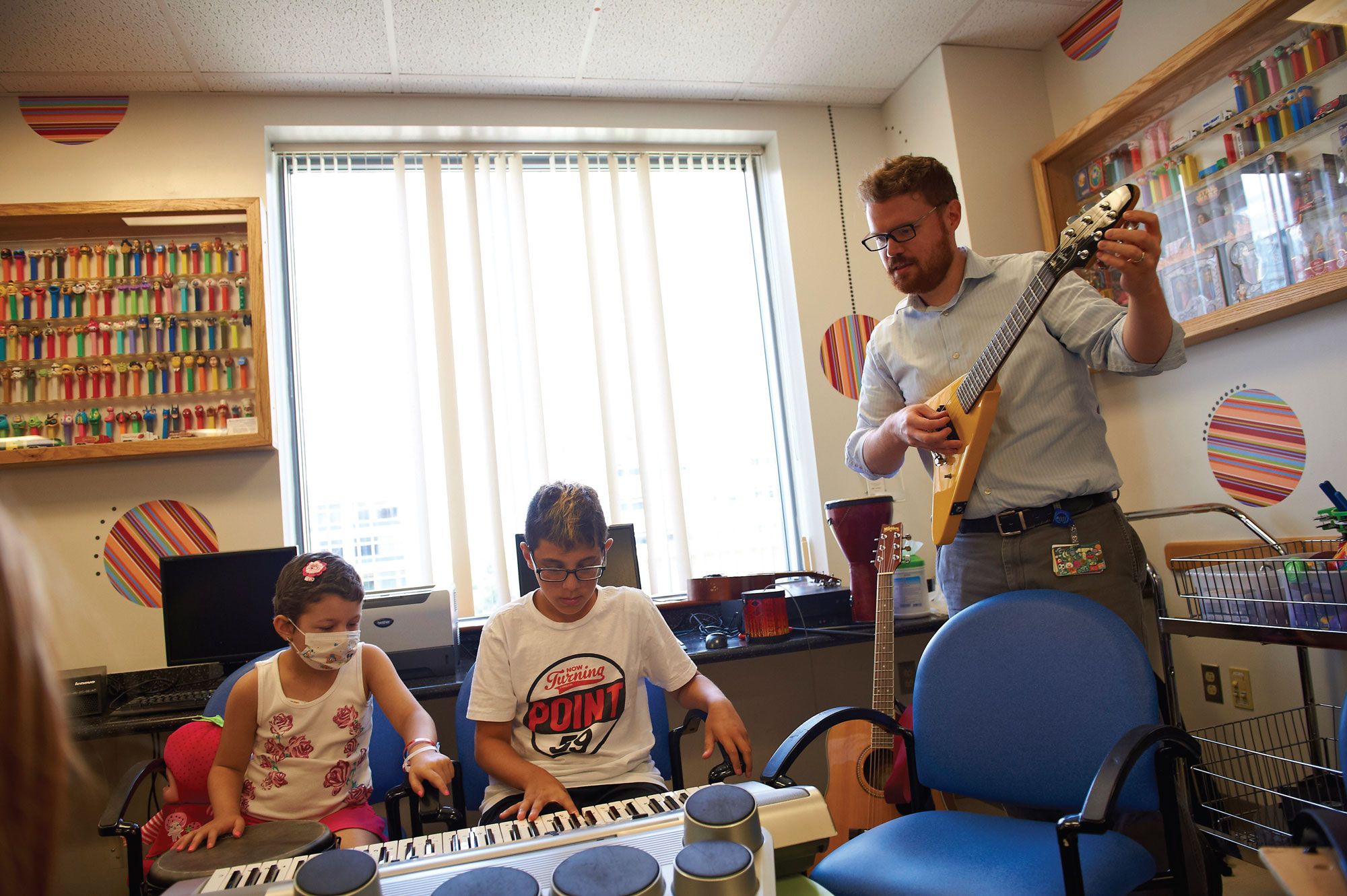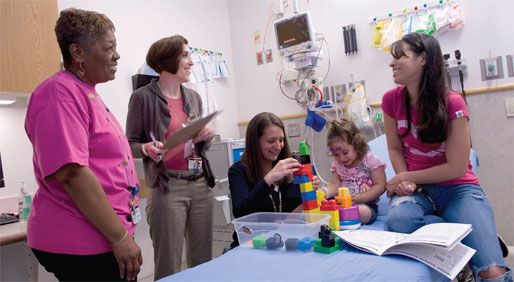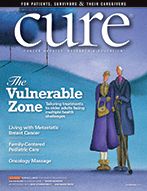In a Family Way: Incorporating Suggestions of Children, Parents and Siblings Into Care
Pediatric cancer facilities that offer family-centered care incorporate the suggestions of children and their parents and siblings into treatment, increasing patient satisfaction and, possibly, health outcomes.
Since birth, Sophie Pettengill has been strong-willed, has disliked being restrained and had had anxiety about visiting the doctor. So when she was diagnosed with acute lymphoblastic leukemia (ALL) at 2 ½, her mother feared that all the treatment she was facing would break her spirit. Just a year before, on a family vacation to Africa, Sophie had earned the nickname Shumba, meaning “little lion cub.”
In her first few months of treatment at Dana-Farber/Boston Children’s Cancer and Blood Disorders Center, a senior member of the psychosocial team worked with Sophie, coming to every blood draw and helping to distract her. The expert employed medical play therapy and other techniques, so that Sophie went from “terrified and screaming to hopping up on the bench and lifting her shirt,” says her mother, Julia Pettengill, of Brookline, Massachusetts.
“They were really committed to her having the healthiest experience emotionally, psychologically and medically, and for our family,” Pettengill says. “They adjusted in some really big ways to make that happen. They’ll make it work for you however it works for your family.” This type of partnership is typical of the kind of family-centered care practiced in leading pediatric oncology hospitals. At its best, family-centered care is more than a marketing slogan. It’s a mindset woven into every aspect of a hospital’s culture. It means including the ideas of parents, teens and kids in the design of the treatment centers, as well as in the way the staff provides all aspects of care and support, including end-of-life care. It calls for training the entire staff and inviting parents and teen patients to talk with them about how to provide compassionate, inclusive care and improve patient and family experiences. Then, these staff members consider the perspectives offered by family members, and sometimes follow their advice.
[Photo courtesy of Julia Pettengill]

Erin Santa Croce, an outpatient nurse at Dana-Farber/Boston Children’s, cleans Sophie Pettengill’s port-a-cath, an IV device implanted under the skin to deliver chemotherapy and other medications. After a few months of intense psychological support, Sophie’s anxiety subsided so much that she’d hop up onto the table for treatment. [Photo courtesy of Julia Pettengill]
At their core, hospitals with a family-centered care approach recognize that, when a child is diagnosed with cancer, the whole family is affected. While the first goal is to treat the child’s cancer, hospitals that provide family-centered care treat the whole person, not only inviting families to have a voice in the child’s care, but providing psychosocial support to both patients and their families. Multiple medical societies, health care systems, state and federal legislative bodies, the Institute of Medicine, and Healthy People 2020 have recognized both family- and patient-centered care as integral to patient health, satisfaction and health care quality, according to a report in the Maternal and Child Health Journal published in February 2012.
“As a pediatric oncologist, you can’t take care of a patient as an independent being. Parents are inextricably linked,” says Amy Billett, a medical doctor and director of safety and quality at Dana-Farber/Boston Children’s. “Today, we’re more cognizant of the issues that affect families, not just patients.”
Nobody knows how widespread family-centered care is in U.S. hospitals because it hasn’t been extensively studied, but after beginning in pediatrics, it is becoming the standard of care for all patients and families, says Beverly H. Johnson, president and CEO of the Institute for Patient and Family-Centered Care. A study published in 2015 shows that 38 percent of nearly 1,500 hospitals surveyed had a patient and family advisory council, and 68 percent encouraged families to participate in shift-change reports.
Massachusetts mandated patient and family advisory councils in all acute-care and rehabilitation hospitals in 2010 and remains the first and only state to have done so, according to Health Care for All, a Massachussetts nonprofit. These kinds of councils first emerged in the late 1990s, with the Dana-Farber Cancer Institute among the first to establish them.
[Photo courtesy of Julia Pettengill]

In the resource room of Dana-Farber/Boston Children’s Cancer and Blood Disorders Center, a volunteer uses play therapy to help Sophie Pettengill, 3, get comfortable with an MRI machine. [Photo courtesy of Julia Pettengill]
In general, patient and family advisory councils comprise some 20 patients and/or their family members, along with a handful of hospital administrators; they meet monthly to provide input and feedback on a wide range of issues, including patient safety, quality of care, internal and external communication, facilities, staff training, operations and cultural observances. Committee members try to reach consensus when making a recommendation to staff members. At some hospitals, members are required to serve on at least one subcommittee in an advisory role to represent the patient’s perspective.
“There are a lot of organizations across the country that are recognizing that when you really partner with families and surround them with a team of professionals, you’re better able to support them and you have better outcomes,” says Rachel Biblow, senior director of patient and family services at Children’s Hospital of Philadelphia (CHOP) Cancer Center.
Built Into the Culture
Before World War II, pediatric hospitals limited parents’ visiting hours. By the middle of the 20th century, hospitals recognized the trauma caused by separating children from their families and changed polices to allow rooming-in, open visiting hours and sibling visits. Patient- and family-centered care in pediatrics began in the mid-1960s. Support for that philosophy of care grew, and in 1987, the Surgeon General called for coordinated, family-centered care for children with special health care needs and their families. More groups advocated for the practice, and in 2001, the Institute of Medicine (now called the National Academy of Medicine) said patient-centered care was crucial to health care quality. In 2003, the American Academy of Pediatrics affirmed family-centered treatment as the standard of care for all children.The strategy made a difference for 6-year-old Lauren Barkman.
When her medical team tried to address her severe constipation, a common side effect of chemotherapy, nothing was working, recalls her mom Darlene Barkman, of Richboro, Pennsylvania. Lauren’s dad, Pete Barkman, asked whether they could give her mineral oil, saying it had worked in the past. The team met and discussed it, and decided that it would be safe to try. Not only did it give her relief, but it showed that the medical staff was open to listening to parents and really taking their input into consideration, Darlene Barkman says. In a setting that is truly family-centered, says Pettengill, parents feel respected and valued. “It’s not because they’re tolerating you,” she says, “but because they truly believe that you’re part of the medical team.” Pettengill has experienced that many times as vice chair of the Dana-Farber/Boston Children’s Pediatric Patient and Family Advisory Council. Many hospitals with family-centered programming establish such parent advisory councils to meet regularly and provide input on a variety of factors, including ways to improve patients’ and families’ experiences. Hospitals considered the leaders in family-centered care, such as Dana-Farber/Boston Children’s, St. Jude Children’s Research Hospital and CHOP, also incorporate additional structures designed to give each patient’s family a voice in their child’s care — matched to the family’s comfort level.
One aspect of family-centered care is that hospitals admit mistakes, apologize and explain how they’ll be corrected.
[Photo courtesy of Julia Pettengill]

Julia Pettengill with her daughter, Sophie. [Photo courtesy of Julia Pettengill]
“So much of the time, negative events that you see in the literature and in lawsuits are related to a breakdown in communication,” says Alicia Huettel, a nurse and director of family-centered care at St. Jude. The mistake can often be forgiven, she says. “How you treat the person is what they remember.”
The family-centered approach recognizes that having a child with cancer puts a strain on family relationships, finances, time and health. Hospitals with family-centered care offer whatever families need, including psychosocial support to help the parents and siblings cope and financial counseling. They help school-aged patients keep up with schoolwork and provide guidance, support and advocacy when patients return to school, since many need educational accommodations. However, families often have to ask for that help.
Leading hospitals that offer these techniques provide a team approach to care, with a psychologist, social worker, nurse, oncologist and child life specialist available to work with the patient, parents and siblings. If the services of a mental health professional are not automatically offered, patients’ families should ask for that help if they need it.
Valuable insights can come from any of these trained professionals, as Debbie Higgins discovered. At the beginning of her son’s treatment at St. Jude, she was pulled aside by a nurse who mentioned that parents who feel badly for their sick children may be reluctant to set limits for them, instead being tempted to bribe and spoil them. The nurse urged Higgins not to treat her child any differently because he has cancer, and she was grateful for the advice.
“The way she said it was so caring. She was saying it to help me,” Higgins says. “These are difficult conversations that they have to have, for the good of the child.”
Patient satisfaction is only part of what is achieved through family-centered care. Medical facilities that incorporate this philosophy believe that, when families and the staff work in partnership, they also end up with healthier patients. For instance, studies show that, when parents are actively involved in their child’s care, medication compliance levels are higher and complication rates are lower, says Jennifer Mack, a pediatric oncologist at Dana-Farber/Boston Children’s and assistant professor in pediatrics at Harvard Medical School.
“Family-centeredness can decrease the length of stay in the hospital as well as unplanned visits to the ER,” Mack says. Better medication adherence is associated with a higher chance of a cure with some patients, such as those with leukemia who take oral medications at home, she adds. “It’s a very reasonable hypothesis that family-centered care may offer improved outcomes, but no one has shown a direct link to date.”
Without optimal central IV line education and care at home, there’s a greater risk of infection, Billett points out. During a meeting with medical staff, the two parent representatives said that parents, rather than being upset at being coached, would welcome the chance to demonstrate their central line-care practices and receive a professional critique on how they could improve.
Challenges
“Our strategy of focusing on optimal central line care allowed us to reduce infection by 28 percent over several years,” she says.Not every doctor and nurse sees the point of doing bedside rounds with the family and giving them a say in treatment. Helping staff to understand the value of and embrace this partnership with patient families is an integral concept of family-centered care, Huettel says. “The advantages always outweigh what I would call challenges,” she says. “Does it cost more resources, money or people? It can. Until you hone your skills as a communicator, it’s going to take more time. And it can be more awkward, initially, but better communication means better care.”
Another challenge to complete adherence is that some staff members have misconceptions about what family-centered care is, says Biblow, with CHOP.
“People say, ‘I don’t have time to talk to the family that way. I went to medical school. Why is the family going to direct the care?’ The challenge is to help engage those providers,” she says. “It’s not family-directed care. It’s not ‘the family is always right.’ It saves time, saves money and saves aggravation.”
For example, she says, families can avoid emergency calls to the doctor and emergency room visits if they understand the normal side effects of medication and when to be concerned.
All of that said, gathering a diverse representation of parent voices can be difficult for several reasons. For example, non-English speakers may not be able to fully participate on an advisory council. Accommodations, such as the provision of interpreters, need to be considered to assure that barriers like this can be eliminated.
Parents' Perspectives Considered
Since every parent can’t devote the time to serving on an advisory board, St. Jude developed an E-council, an online way for parents to participate as advisers, even if they can’t attend meetings. This has helped to draw from a broader sampling of parent perspectives. Through the E-council, parents may respond to surveys, share information about their experiences and offer ideas for improvement.Lauren Barkman was 6 when she was diagnosed with ALL in 2006, and absolutely refused to have a port put in to ease the administration of medication. “My husband said, ‘This kid has lost all control of her life; she’s going to lose her hair; she can’t go to school. She has no say. We’re not doing the port,’” recalls Darlene Barkman.
The family met with their CHOP medical team and explained why they didn’t want Lauren to be forced to get the port. The medical staff explained to Lauren that she was facing two years of IVs, and that if her veins didn’t cooperate, they’d have to revisit the no-port approach. But they agreed to let her forgo the port.
“They met us where we were. They were totally fine with us and used it to continue to educate us on the ‘what,’ the ‘how,’ and the ‘what if.’ She went through her entire treatment without a port,” Barkman says. In a truly family-centered setting, parent perspectives are used to improve care for all patients, not just their own little ones. When Julia Pettengill joined the parent advisory council, she pointed out parents’ sense that the staff could do a better job preparing families for making the transition off of care. While she felt the hospital does a phenomenal job at understanding how parents are feeling when their child is diagnosed with cancer, she says, clinicians were underestimating how stressed families were at the end of treatment.
“Family and friends’ expectation is that you should celebrate,” she says. But when treatment ends, transitioning from that bubble of active treatment with your care team, where everyone really knows your child and family, to the regular health care of your pediatrician is “an anxiety-inducing time.”
[Photo Courtesy of CHOP Cancer Center]

At Children’s Hospital of Pennsylvania, a social worker meets with a 10-year-old kidney transplant patient. [Photo courtesy of CHOP Cancer Center]
At first, parents on the advisory council had to convince the clinical staff that their feelings were not unique to them. But a year after bringing it up, Pettengill says, parents convinced staff that it was as important to prepare families for the end of treatment as it is at the beginning. Clinical staff worked with parents to implement psychosocial supports to help them make the transition to life after treatment. They created information sessions, a page on the website, a blog and a Google live chat, which included parents, doctors, the head of psychosocial services and a former pediatric patient who is now an adult.
“It wasn’t necessarily something that was on their radar,” she says. “But once they were on board, it was: ‘We hear you; we believe you; we trust you.’ ”
Each hospital offers something different. St. Jude and CHOP, in response to similar parent concerns, established parent-to-parent mentors, invited families back for social events and programs, and provided family counseling and post-treatment, age-appropriate therapy.
Sibling Support
A parent whose child had passed away from cancer suggested that Dana-Farber/Boston Children’s organize a get together for parents who had lost a child, but asked that it not be a support group. This fall, it held its second annual bereaved parent cruise, where parents gathered for a social event with other people who understood their loss, says Lisa Scherber, director of patient and family programs at Dana-Farber/Boston Children’s.Family-centered care also extends to children and teenagers with a sibling receiving treatment for cancer — of whom there are 18,000 in the United States in any given year. Research suggests that siblings often fare worse than the child with cancer in terms of their social and emotional well-being, says Lamia Barakat, director of psychosocial services and behavioral oncology research at the CHOP Cancer Center and a professor of clinical psychology in pediatrics at the University of Pennsylvania.
Hospitals that embrace family-centered care have multiple programs and practices designed to help siblings and the entire family weather the experience.
“When this treatment is over, no matter how the treatment ends, we want to make sure this family is whole, that the patient doesn’t have to reenter the family,” Scherber says. “You want to feel the brothers and sisters are there to support you.”
[Photo Courtesy of CHOP Cancer Center]

At CHOP, music therapy helps patients to work through complicated emotions about their hospitalization and medical challenges. Music helps them express themselves, relax and have fun. [Photo courtesy of CHOP Cancer Center]
The day after Sophie Pettengill was diagnosed, the Dana-Farber/Boston Children’s sibling specialist came to talk to her parents about Sophie’s sister Ava, who was 7.
“At the end of this treatment, we want you to have two thriving kids,” the sibling specialist told Julia and Mark Pettengill. She then told them about the weekly sibling group meetings and welcomed Ava to stay overnight in the hospital and participate in family events.
“I’m not going to say it isn’t tough, that there aren’t sibling issues,” Julia Pettengill says, but “I feel we were really set up to hold both of our children through treatment.”
At Dana-Farber/Boston Children’s and St. Jude, children with cancer are given glass and ceramic beads that represent milestones in their cancer treatment. Siblings are also given beads to mark milestones they experience because their brother or sister has cancer, rewarding them for being strong and recognizing sacrifices siblings make by spending time in the clinic or for participating in sibling support programs. Ava and other siblings sang on a CD with Sophie and other patients. Siblings were invited to events and outings that were for them only, and, other times, when events were offered for patients and their families, Ava was invited to bring a friend if her sister was too sick to go.
Parent Advisory Councils
“Those are powerful things that help them feel, ‘I have a story too. This is part of my childhood that I lost,’” Pettengill says. “Ava, to this day, feels as at home at the hospital and clinic as Sophie does. Ava never felt she was a tag-along to the patients. She felt she was a complete equal.”Family-centered care also makes parents feel recognized.
Parent advisory council leaders at St. Jude, CHOP and Dana-Farber/Boston Children’s say these councils have clout and influence. St. Jude established a Family Advisory Council in 2008. Initially, says Higgins, chair of the parent advisory board, parents were underutilized, but over time, that has changed as parents earned the staff’s respect.
“At first, no one wanted to talk in front of a patient family,” Higgins says. “Once they learned how much information they could get from a patient family, it’s helped.”
Also at St. Jude, parent advisers attend the nursing unit council meetings where staff share quality reports; when scores are low, the nurses ask parents how they can improve, Higgins says. They listen and report back the next quarter, outlining how they implemented the parents’ recommendations and the ways they improved.
[Photo Courtesy of CHOP Cancer Center]

Periodically, CHOP staff members interview parents of children receiving care in the Emergency Department to gauge how well doctors and nurses are communicating with families. [Photo Courtesy of CHOP Cancer Center]
In response to parental input, one of the first things St. Jude’s parent advisory council did was to establish a formal parent mentoring program, and then expanded it to provide parent mentors to those facing end-of-life issues.
When the initial family support group meetings at St. Jude were not well-attended, instead of abandoning the idea, the hospital provided coffee talks and social events at which parents could get together and talk informally. Huettel, family-centered care director, says she was there to make coffee and answer questions, but not to facilitate.
“Not everything we would like will always get approved,” Higgins says. “But they will take a look at everything.”
Patient- and family-centered care began in pediatrics, and as it becomes standard for all patients, parents and families are leading the way, says Johnson. At a cancer center in Florida, teenagers are helping develop the end-of-life care directives. At Dana Farber, families are teaching physicians at the beginning of their careers about family-centered care.
C
“I think, today, there’s much more receptivity and understanding that families need to be very much a part of their child’s care,” she says. “We can’t do it safely and cost-effectively without family involvement.”
